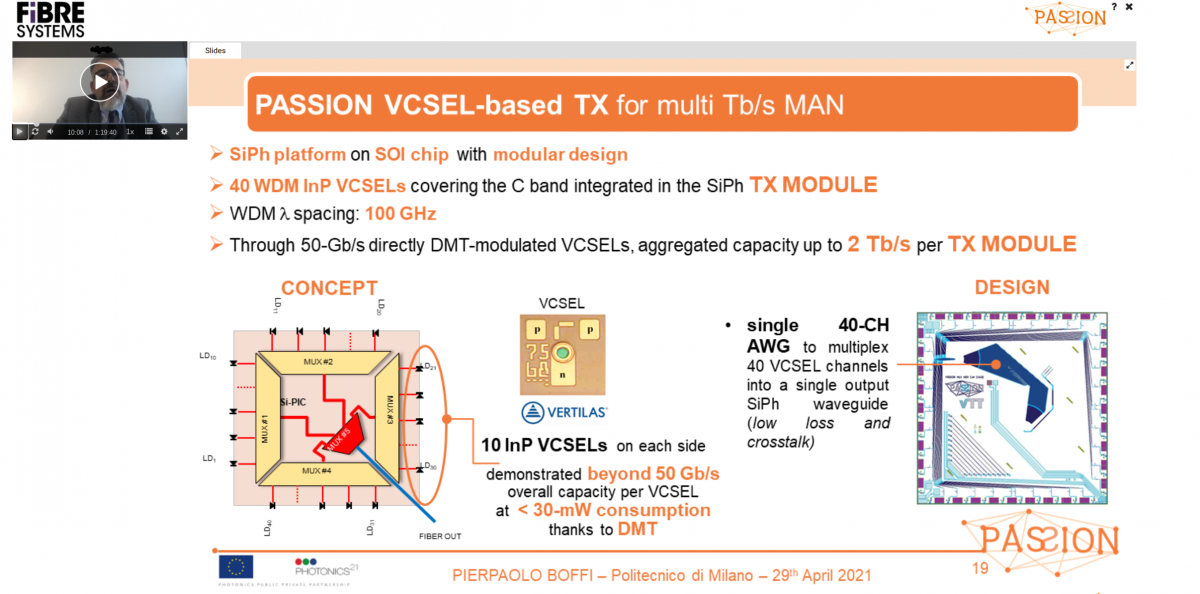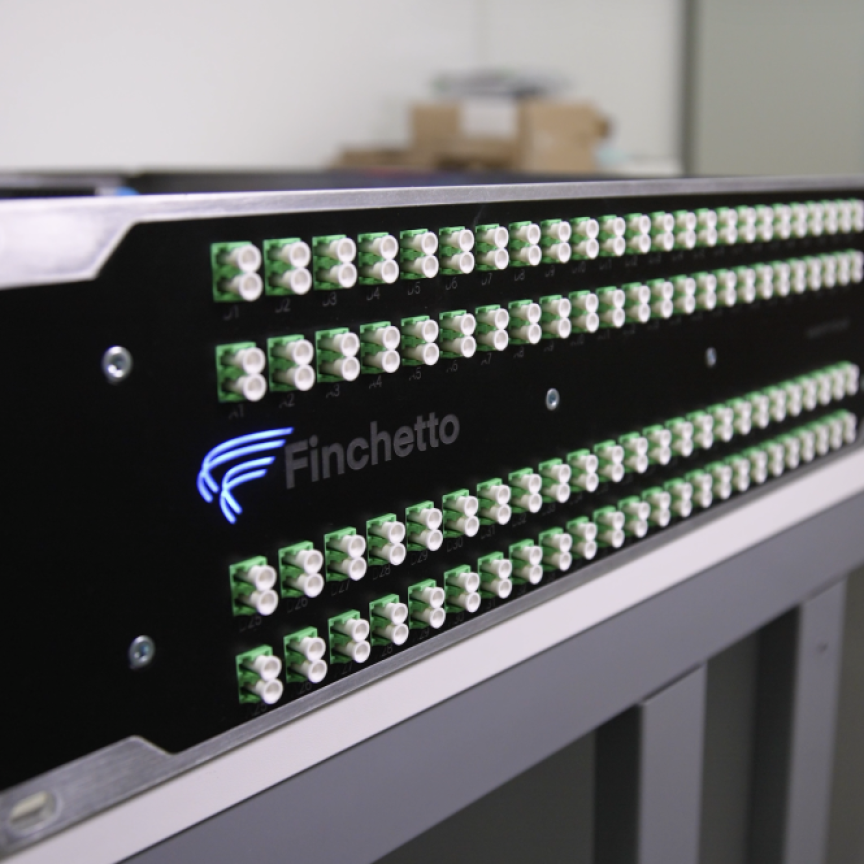Panelists from Polimi, CTTC, TUE and The University Carlos III of Madrid give their views on the future multi Tb/S metro network
The Passion project was set up to realise a platform based on photonic technologies that will support the development of the future metropolitan communications network. Funded by the Horizon 2020 European programme, its goal is to provide innovative transmission, detection and routing solutions, and a new network architecture to ensure a transmission rate of more than 100Tb/s per link and a switching capacity of over 1Pb/s per node.
At a recent webcast, four panelists discussed the project’s work in developing innovative photonic devices, as well as optical fibre network infrastructure for the future metropolitan area network.
Module behaviour
Pierpaolo Boffi, associate professor at Politecnico Di Milano (Polimi) revealed how the group developed a VCSEL-based transmitter module (TX) for multi-terabit metro networks. He explained: ‘The Passion approach is based on the expectation of low cost, energy efficient, directly modulated sources such as VCSELs, and their benefits in terms of cost are well known. Nowadays GaAs VCSELs in multimode operation are massively employed by ISPs for data communications.’
The VCSELs used for this project, however are indium phosphide (InP), which can operate in a single mode and are characterised by emission in the C-band. These kinds of VCSELs can be modulated directly with multi-level modulation format such as PAM4, or multi carrier modulation format such as DMT. ‘DMT is a very promising modulation format,’ he said, ‘because it can increase the transmission rate of the VCSEL. We are demonstrating more than 50Gb/s capacity per VCSEL.’
40 VCSELs covering the C-band were integrated in a silicon photonic platform single ASIC to realise 2Tb/s for the transmitter module, considering 50Gb/s capacity per VCSEL. ‘This 2Tb/s module is the fundamental building block in the Passion approach,’ said Boffi. ‘We achieved a low loss, and low crosstalk thanks to an SOI coupling between the silicon substrate and the waveguide, exploring a 45° upper reflecting mirror to maximise the coupling between the VCSEL emission and the silicon waveguide.’
The modular approach meant that multiple identical TX modules could be used to build a super-module to increase capacity. ‘By combining four such identical modules,’ said Boffi, ‘we can realise a super-module with 160 wavelength division multiplexing (WDM) channels corresponding to 160 VCSELs with a granularity of 25GHz. To achieve a transmitter, we have enabled the capacity of 8Tb/s and we can also exploit polarisation division multiplexing by combining the outputs of two identical super modules to achieve 16Tb/s.’

Building blocks
Svaluto Moreolo, senior researcher at Catalan Telecommunications Technology Centre (CTTC) discussed the group’s work in producing a sliceable bandwidth/bitrate variable transceiver (S-BVT). ‘Like Pierpaolo said in his previous talk,’ she explained, ‘the approach we use is modular. It is important to use the building blocks of the Passion technologies and devices, and that they are pay-as-you-grow and license-based module activation.’
The S-BVT uses a programmable, softwaredefined networking (SDN) controlled modular architecture, with directly modulated (DM) VCSELs. On the receiver side, coherent receivers were selected with tunable local oscillators. It has full digital signal processing (DSP) and spectral manipulation thanks, said Moreolo, ‘to the DSP that can be applied and also considering the different contribution of the flows generated by means of different VCSEL operating wavelengths.’
Adaptive multicarrier modulation (MCM) can be used at DMT/OFDM with power loading, allowing sub-wavelength at the level of the MCM subcarriers to help optimise the capacity. The target capacity per flow was 50Gb/s with more than 18GHz VCSELs. Moreolo added that an SDN controller will be used to program and set up the multi-terabit connection in metro networks, and it is through this that the S-BVT will be configured.
On the nodes
Eindhoven University of Technology’s (TUE) Nicola Calabretta discussed the Passion modular network nodes based on photonic integrated switches. He explained: ‘Next generation networks, especially metro, are moving their network density from 5G to 6G, and so will require extreme device densities, higher volume and dynamic traffics, very high data rates, lower latency and energy efficiency.’ A large number of nodes are required for this interconnectivity and these are divided into an aggregation layer and a core layer.
Looking at next generation networks with edge computing nodes, there are attributes such as telecom and datacom convergence for a metro access node, in particular at the edge node. It will also need variable bandwidths to cope with the dynamic traffic. Its latency sensitivity means that it should be fast switching and a large amount of nodes are needed for scalability. Moving to the metro core node, there is more static aggregated traffic, said Calabretta, so reach-of-speed is not so critical. ‘But the capacity is going to be multiple hundreds of terabits-per-second,’ which reiterates the requirement for a modular, pay-as-you-grow solution. Because the metro core nodes are such high capacity, the group used multi-core fibre, which enters the node and goes through pulse spacing modulation (PSM) to a space switch. Calabretta explained: ‘The space switch has two functionalities, one is to direct traffic as it passes through to the output, but some of the traffic will be dropped, in a sense to the aggregation, and disaggregator switch. In this case, the programmability allows us to redirect some of this traffic. We try to merge the traffic that needs to go in the same direction because, at the next node, a bypass photonic space switch allows us to send a signal directly to the express port and ensure very low losses.’
Keep it simple
Looking at the metro access node, Calabretta reiterated the need for simplicity and low cost. ‘We used a simple two-degree ROADM for add/drop multiplexing, which is capable of adding or dropping traffic in a dynamic way. The difference is that we are using a semiconductor optic amplifier as a key element for a fast operation.’ The modular and photonic integrated wavelength selective switches (WSS) needed to be designed and built accord to the aforementioned characteristics, one based on hybrid photonic integration and silicon photonics (SiPh) and InP, and the other as a fully monolithic integrated InP WSS. The hybrid WSS was demonstrated to be useful for exploiting co-integration with the high-performance passive (de-) multiplexer in SiPh and InP semiconductor optical amplifiers for on-chip switch and amplification. The monolithic WSS, meanwhile, provided lossless operation, offering potential applications for edge computing interconnect and intra data centre networks.
The results
David Larrabeiti, a professor at the University Carlos III of Madrid, explained how the metro network is exploiting Passion technologies from an operator’s view, moving away from the traditional approach, which uses a proliferation of transceivers in the internet protocol/ WDM. ‘Passion SBVTs offer a different point of view,’ he said. ‘We have a device capable of simultaneously establishing connections to different nodes at the same time. Just with a single transceiver, you can do everything. Essentially what you get is a network made up of the Passion ROADMs and you can interconnect the edge with an all optical connection. That is very interesting in terms of cost.’
Larrabeiti gave deployment cost scenarios. The first is with 600Gb/s per HL4 node and CAGR at 15 per cent. In this case, while traffic increases by 15 per cent each year, the capex increases 7.8 and 7.4 per cent for two classical IP over WDM with grooming and bypassing respectively. The Passion solution, hoverver, only increases the capex at a rate of 4 per cent. The other scenario is with 150Gb/s per HL4 node and a CAGR at 40 per cent.
In this case, the Passion solution only increases the capex at a rate of 7.6 per cent, in comparison to the two classical IP over WDM, which see an increase of 15.2 and 13.72 per cent respectively. ‘In conclusion’, said Larrabeiti, ‘the Passion SBVT technology is an ideal new concept to exploit the hierarchical nature of traffic in the metro network. 90 per cent of traffic goes from the edge to the core in metro networks. The license-based pay-as-you-grow scheme allows for savings in opex and there are potential global deployment savings for operators of more than 40 per cent.


